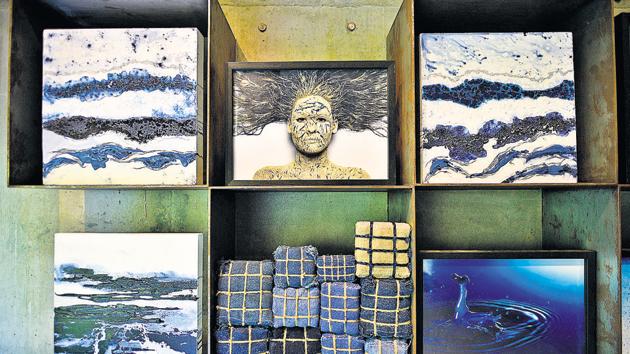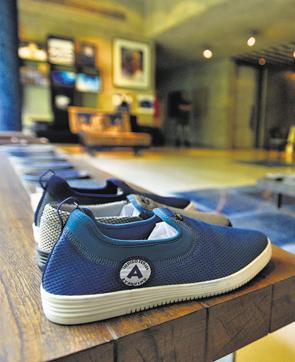For the love of indigo: The upcoming Arvind Indigo Museum in Ahmedabad is all set to create a blue universe
The upcoming Arvind Indigo Museum in Ahmedabad is going beyond the traditional use of the dye on textiles to create a world where literally everything is in varying shades of blue
How far can one individual’s love for a colour extend? For most of us it will end with turning our entire wardrobe black, pink or ivory – whatever be the hue of our choice. Or at most picking up home linen and upholstery in that shade. But Sanjay S Lalbhai, chairman and managing director of the textile company Arvind Ltd, has made it his mission to create an entire indigo universe – and involve others in his pet project.


“If you see indigo as an art form, it is always on fabric – jute, cotton, silk, wool... A bit of pottery – so we thought, let us pull out the limits and try and put it on every conceivable surface,” explains Lalbhai. The result is the upcoming Arvind Indigo Museum in Ahmedabad, which, Lalbhai feels, will be a one-of-a-kind destination for all things indigo.
Back to the roots
For decades Arvind’s India headquarters on Naroda Road, Ahmedabad, has flaunted shades of blue. It started soon after Lalbhai joined the family business in 1979. “The company was set up by my grandfather in 1931. By the time I joined there was this threat from power looms. I had to bring in something new to carry on with the tradition of a very successful company,” recalls Lalbhai. His brother-in-law wanted to make jeans and by 1985 Arvind was manufacturing denim. Today it claims to be the world’s largest manufacturer of the fabric. “Denim gave Arvind a second chance and denim is what it is because of this brilliant dye called indigo,” he says.

For the past year or so, the colour has seeped deeper into his office. On the shelves are arranged varieties of indigo yarn, indigo concrete blocks, glass, papier mache lumps, jute and metal pieces, objects made from recycled waste, wood blocks… the list goes on. There are art works made of these, indigo leather bag, shoes… On one column is draped a piece of indigo kantha embroidery, on a wall hangs an indigo brocade design and in a corner lies heaped, sheets of indigo leather. While some of these will probably find their place among the museum exhibits, they are really the outcome of experiments by Arvind to figure out what kind of indigo composition worked for the different surfaces. “We then reached out to artists with our recipes and toolkits. Most of them had never worked with indigo,” says Lalbhai. Some of the artists Arvind has commissioned pieces to for the project include Nalini Malani, Alwar Balasubramaniam, Manish Nai and Tanya Goel.
Beyond Borders
Lalbhai has also tapped the talent pool abroad. Aboubakar Fofana, one of the foreign artists Arvind has roped in, has been working with the dye for decades. Born in Mali and raised in France, Fofana is, as his website mentions, a multidisciplinary artist and designer known for his work in reinvigorating and redefining West African indigo dyeing techniques.
Traditional artisans are also part of the project. Paresh Vishnu Bhai Patel, a master weaver of Asawali, a kind of brocade traditional to Gujarat, says, “We have shown the indigo work we have done to some designers and received a favourable response. We might take it up commercially.” This is the exact kind of support that Lalbhai is hoping to create. “We are going to create a whole ecosystem to revive traditional Indian art through indigo and then see how we can make it more commercially viable work for them, by say helping them make their work more contemporary, so we can reach out to a more global audience,” he explains. The Mata ni Pachedi – a traditional art form in Gujarat – artists are also experimenting with indigo for this project.

In The Future
Of course, the use of indigo in India is not new. According to Oxford’s online dictionary the origin of the word came from the Greek word ‘indikos’ or ‘Indian (dye)’. What Arvind has done is simply to extend its scope. The exhibition will open at the Kasturbhai Lalbhai Museum complex – an old house belonging to the Lalbhai family that has been turned in to an art museum – in the last week of January. Apart from the artworks commissioned by Arvind, the display will include the history of indigo. Artisans will demonstrate their skills and visitors will be shown how the dye is made from the plant. After three months, the exhibition will shift to the Arvind headquarters, where a permanent display area for visitors is being built.
The project also includes a residency for artists, again filled with indigo pieces, from sofas, curtain and bathroom tiles to artworks. Lalbhai hopes, the museum will have the support of other brands working with the dye and will become an evolving project. The one thing he has to work on is the cultivation of the dye. Denim uses synthetic indigo – the price of the natural dye is, he says, five times more. But the company has been working with the natural dye for this project. The cultivation process is labour intensive. If demand grows, as Arvind hopes it will, cultivation will have to be made profitable for the farmers. In India, indigo cultivation already has a past of peasant exploitation under the British.





